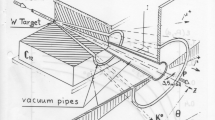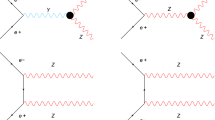Abstract
We have studied the loosely bound \(D^{*}\bar{D}^{*}\) system. Our results indicate that the recently observed charged charmonium-like structure Z c (4025) can be an ideal \(D^{*}\bar{D}^{*}\) molecular state. We have also investigated its pionic, dipionic, and radiative decays. We stress that both the scalar isovector molecular partner Z c0 and three isoscalar partners \({\tilde{Z}}_{c0,c1,c2}\) should also exist if Z c (4025) is a \(D^{*}\bar{D}^{*}\) molecular state in the framework of the one-pion-exchange model. Z c0 can be searched for in the channel e + e −→Y→Z c0(4025)(ππ)P-wave where Y can be Y(4260) or any other excited 1−− charmonium or charmonium-like states such as Y(4360), Y(4660), etc. The isoscalar \(D^{*}\bar{D}^{*}\) molecular states \({\tilde{Z}}_{c0,c2}\) with 0+(0++) and 0+(2++) can be searched for in the three pion decay channel \(e^{+}e^{-}\to Y \to {\tilde{Z}}_{c0,c2} (3\pi)^{I=0}_{\text{P-wave}}\). The isoscalar molecular state \({\tilde{Z}}_{c1}\) with 0−(1+−) can be searched for in the channel \({\tilde{Z}}_{c1}\eta\). Experimental discovery of these partner states will firmly establish the molecular picture.

Similar content being viewed by others
References
M. Ablikim et al. (BESIII Collaboration), Phys. Rev. Lett. 110, 252001 (2013). arXiv:1303.5949 [hep-ex]
M. Ablikim et al. (BESIII Collaboration), arXiv:1308.2760
Z.-F. Sun, J. He, X. Liu, Z.-G. Luo, S.-L. Zhu, Phys. Rev. D 84, 054002 (2011). arXiv:1106.2968 [hep-ph]
Z.-F. Sun, Z.-G. Luo, J. He, X. Liu, S.-L. Zhu, Chin. Phys. C 36, 194 (2012)
D.-Y. Chen, X. Liu, Phys. Rev. D 84, 034032 (2011). arXiv:1106.5290 [hep-ph]
W. Chen, S.-L. Zhu, Phys. Rev. D 83, 034010 (2011)
H.Y. Cheng, C.Y. Cheung, G.L. Lin, Y.C. Lin, T.M. Yan, H.L. Yu, Phys. Rev. D 47, 1030 (1993). arXiv:hep-ph/9209262
T.M. Yan, H.Y. Cheng, C.Y. Cheung, G.L. Lin, Y.C. Lin, H.L. Yu, Phys. Rev. D 46, 1148 (1992) [Erratum—ibid. D 55, 5851 (1997)]
M.B. Wise, Phys. Rev. D 45, 2188 (1992)
G. Burdman, J.F. Donoghue, Phys. Lett. B 280, 287 (1992)
R. Casalbuoni, A. Deandrea, N. Di Bartolomeo, R. Gatto, F. Feruglio, G. Nardulli, Phys. Rep. 281, 145 (1997). arXiv:hep-ph/9605342
A.F. Falk, M.E. Luke, Phys. Lett. B 292, 119 (1992). arXiv:hep-ph/9206241
W.A. Bardeen, E.J. Eichten, C.T. Hill, Phys. Rev. D 68, 054024 (2003). arXiv:hep-ph/0305049
V.M. Belyaev, V.M. Braun, A. Khodjamirian, R. Ruckl, Phys. Rev. D 51, 6177 (1995). arXiv:hep-ph/9410280
F.S. Navarra, M. Nielsen, M.E. Bracco, Phys. Rev. D 65, 037502 (2002). arXiv:hep-ph/0109188
F.S. Navarra, M. Nielsen, M.E. Bracco, M. Chiapparini, C.L. Schat, Phys. Lett. B 489, 319 (2000). arXiv:hep-ph/0005026
Y.-B. Dai, S.-L. Zhu, Eur. Phys. J. C 6, 307 (1999). arXiv:hep-ph/9802227
C. Isola, M. Ladisa, G. Nardulli, P. Santorelli, Phys. Rev. D 68, 114001 (2003). arXiv:hep-ph/0307367
S. Ahmed et al. (CLEO Collaboration), Phys. Rev. Lett. 87, 251801 (2001). arXiv:hep-ex/0108013
S. Ohkoda, Y. Yamaguchi, S. Yasui, A. Hosaka, Phys. Rev. D 86, 117502 (2012). arXiv:1210.3170 [hep-ph]
Y.-R. Liu, arXiv:1304.7467 [hep-ph]
Q. Wang, C. Hanhart, Q. Zhao, arXiv:1303.6355 [hep-ph]
F.-K. Guo, C. Hidalgo-Duque, J. Nieves, M.P. Valderrama, arXiv:1303.6608 [hep-ph]
M.B. Voloshin, Phys. Rev. D 87, 091501(R) (2013). arXiv:1304.0380 [hep-ph]
J.-R. Zhang, Phys. Rev. D 87, 116004 (2013). arXiv:1304.5748 [hep-ph]
Acknowledgement
This project is supported by the National Natural Science Foundation of China (Grants No. 11275235, No. 11075004, No. 11021092, No. 11035006, No. 11047606, No. 10805048), and the Ministry of Science and Technology of China (No. 2009CB825200), and the Ministry of Education of China (FANEDD under Grants No. 200924, DPFIHE under Grants No. 20090211120029, NCET under Grants No. NCET-10-0442, the Fundamental Research Funds for the Central Universities under Grants No. lzujbky-2010-69), the Knowledge Innovation Project of the Chinese Academy of Sciences (Grant No. KJCX2-EW-N01).
Author information
Authors and Affiliations
Corresponding authors
Rights and permissions
About this article
Cite this article
He, J., Liu, X., Sun, ZF. et al. Z c (4025) as the hadronic molecule with hidden charm. Eur. Phys. J. C 73, 2635 (2013). https://doi.org/10.1140/epjc/s10052-013-2635-z
Received:
Revised:
Published:
DOI: https://doi.org/10.1140/epjc/s10052-013-2635-z




